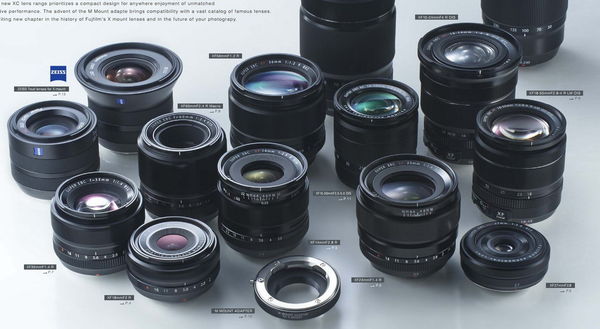Mirrorless Interchangeable Lens Technology
Jul 22, 2014 09:24:16 #
Dale40203
Loc: Louisville, KY
Interchangeable mirrorless cameras have a couple of obvious advantages over DSLRs. Less bulk due to the absence of the pentaprism and mirror, and smaller lenses for the same focal length and aperture. There are problems still with electronic view finder speed, but that's still new technology and will likely improve.
My question concerns whether lenses for mirrorless cameras will be easier (if not cheaper) to design and manufacture to the high standards required by hi-res cameras.
I'm not sure how many of the legacy SLR film lenses are actually up to resolving 20+ megapixel sensors, so starting from square one with the new mirrorless format should be a good thing. So far, the only full frame mirror less camera (Sony Alpha 7) has few dedicated lenses available, and everything Nikon and Canon offer for their full frame DSLRs is hung over from the 35mm film days.
Any other thoughts on the development of mirrorless interchangeable cameras would be appreciated.
My question concerns whether lenses for mirrorless cameras will be easier (if not cheaper) to design and manufacture to the high standards required by hi-res cameras.
I'm not sure how many of the legacy SLR film lenses are actually up to resolving 20+ megapixel sensors, so starting from square one with the new mirrorless format should be a good thing. So far, the only full frame mirror less camera (Sony Alpha 7) has few dedicated lenses available, and everything Nikon and Canon offer for their full frame DSLRs is hung over from the 35mm film days.
Any other thoughts on the development of mirrorless interchangeable cameras would be appreciated.
Jul 22, 2014 09:34:43 #
Apparently they still use a mechanical shutter. Although I don't see one when I change lenses on my NEX-7. In any case I don't see a reason they can't go to fully electronic shutters.
There are a bunch of adapters that will let me physically connect my Nikon lenses to the Sony...but none of them allow using the lens electronically. Since many of the new Nikon lenses do not have an aperture ring that kinda sucks.
I wish Nikon would come out with a decent mirrorless camera that uses existing lenses. They seem to have gone in a stupid direction with their small sensor ones.
There are a bunch of adapters that will let me physically connect my Nikon lenses to the Sony...but none of them allow using the lens electronically. Since many of the new Nikon lenses do not have an aperture ring that kinda sucks.
I wish Nikon would come out with a decent mirrorless camera that uses existing lenses. They seem to have gone in a stupid direction with their small sensor ones.
Jul 22, 2014 09:35:03 #
[quote=Dale40203]Interchangeable mirrorless cameras have a couple of obvious advantages over DSLRs. .....and smaller lenses for the same focal length and aperture. .....My question concerns whether lenses for mirrorless cameras will be easier (if not cheaper) to design and manufacture to the high standards required by hi-res cameras.
I'm not sure how many of the legacy SLR film lenses are actually up to resolving 20+ megapixel sensors, so starting from square one with the new mirrorless format should be a good thing. So far, the only full frame mirror less camera (Sony Alpha 7) has few dedicated lenses available, and everything Nikon and Canon offer for their full frame DSLRs is hung over from the 35mm film days.
..../quote]
why should a redesign of lenses be required?
I'm not sure how many of the legacy SLR film lenses are actually up to resolving 20+ megapixel sensors, so starting from square one with the new mirrorless format should be a good thing. So far, the only full frame mirror less camera (Sony Alpha 7) has few dedicated lenses available, and everything Nikon and Canon offer for their full frame DSLRs is hung over from the 35mm film days.
..../quote]
why should a redesign of lenses be required?
Jul 22, 2014 09:36:28 #
I believe that lens resolution is measured in lpm (lines per millimeter) that should be easy to compare to pixels per millimeter. I'm also not sure of which film lenses would be up to the task but it might be reasonably easy to tell.
I just did a quick lookup and the answer might not be as easy to find as I thought. I'll look some more.
I just did a quick lookup and the answer might not be as easy to find as I thought. I'll look some more.
Jul 22, 2014 09:53:17 #
oldtigger wrote:
why should a redesign of lenses be required?
why should a redesign of lenses be required?
To make them smaller and lighter
Jul 22, 2014 09:58:34 #
Dale40203
Loc: Louisville, KY
Oldtigger asks "Why redesign lenses?"
Look at the size difference between full frame lenses for mirrorless cameras and their equivalent for DSLR.
Adapting a 35mm film lens to a mirrorless camera defeats the purpose of having a smaller, lighter body.
The process of going from legacy 35mm cameras to unfettered digital cameras reminds me of evolving from "horseless carriages" to the "automobile".
Look at the size difference between full frame lenses for mirrorless cameras and their equivalent for DSLR.
Adapting a 35mm film lens to a mirrorless camera defeats the purpose of having a smaller, lighter body.
The process of going from legacy 35mm cameras to unfettered digital cameras reminds me of evolving from "horseless carriages" to the "automobile".
Jul 22, 2014 10:06:38 #
Fuji has a full line of lenses for the "X" mirrorless cameras...all redesigned to be small and light and have killer quality.
Jul 22, 2014 10:06:52 #
there are some old film lenses that do a great job of producing super sharp images...I just don't happen to own any that are sharper than my 75 or 45mm native lenses. My old film lenses were purchased inexpensively to either fill a focal length gap or for it's speed. That said, I'll defer to the native mounts to take advantage of the blazing fast AF and image quality.
I've posted this photo before...EM1 and 75mm combo. More than sharp enough for me. Shot handheld at -14 degrees F Zoom in on it and find the fishing bobbers.

(Download)
Jul 22, 2014 10:43:02 #
Cdouthitt wrote:
To make them smaller and lighter
i guess what i was trying to ask is why my 70-200/2.8 fx lens would not be usable on a full frame mirrorless camera.
Why would they have to change the design?
Jul 22, 2014 10:53:43 #
oldtigger wrote:
i guess what i was trying to ask is why my 70-200/2.8 fx lens would not be usable on a full frame mirrorless camera.
Why would they have to change the design?
Why would they have to change the design?
you could...but it would be a tad awkward, balance-wise. At least with olympus, they're able to design their lenses toward the size and weight of of their m4/3 bodies so as to keep everything compact and light as possible. It's not to say all their lenses are small and light. I'd put my favorite lens, the 75mm f1.8 on par with the size/weight of some DSLR lenses.
Jul 22, 2014 10:56:53 #
oldtigger wrote:
i guess what i was trying to ask is why my 70-200/2.8 fx lens would not be usable on a full frame mirrorless camera.
Why would they have to change the design?
Why would they have to change the design?
Only familiar with my own Olympus mirrorless. I use a mix of old and new lenses . The new m43 lenses are designed for m43 cameras and are small, sharp, lightweight and quick. I also have older non-m43 lenses that are larger, heavier, a little slower to focus, and require an adapter, but because they are such excellent glass, I continue to use them rather than spend money on replacements of the same focal lengths.
Jul 22, 2014 11:00:50 #
amehta
Loc: Boston
Dale40203 wrote:
Interchangeable mirrorless cameras have a couple o... (show quote)
Designing lenses for MILCs is easier because the sensor is closer to the lens mount. This is not really a factor for telephoto lenses, where the long focal length and maximum aperture dictate the overall lens requirements. But this is a significant factor for wide angle lenses, where having the lens closer makes it easier to produce the wide image.
Jul 22, 2014 11:08:11 #
amehta wrote:
Designing lenses for MILCs is easier because the sensor is closer to the lens mount. This is not really a factor for telephoto lenses, where the long focal length and maximum aperture dictate the overall lens requirements. But this is a significant factor for wide angle lenses, where having the lens closer makes it easier to produce the wide image.
There you go again, making sense of the original post. Are you sure you don't own one of these cameras?
Jul 22, 2014 11:21:46 #
amehta
Loc: Boston
Cdouthitt wrote:
There you go again, making sense of the original post. Are you sure you don't own one of these cameras?
I don't own any, but it doesn't mean I can't appreciate some of them. :-)
Jul 22, 2014 11:24:28 #
amehta wrote:
Designing lenses for MILCs is easier because the sensor is closer to the lens mount. This is not really a factor for telephoto lenses, where the long focal length and maximum aperture dictate the overall lens requirements. But this is a significant factor for wide angle lenses, where having the lens closer makes it easier to produce the wide image.
If they do something as stupid as reducing the distance between the sensor and lens mount, we could have spacer plates made to go between the mount and lens so that we could continue to use our existing lenses.
If you want to reply, then register here. Registration is free and your account is created instantly, so you can post right away.






